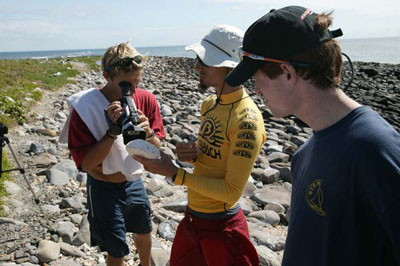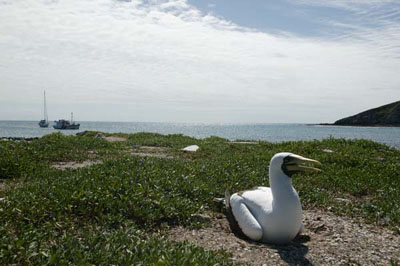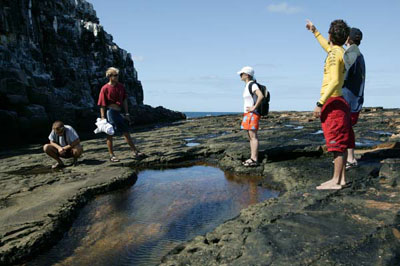Abrolhos by Land
|
Wildlife Co-Captain, Florian, is filming a piece of dried coral, held by Daniel, the IBAMA Park Ranger. Daniel Michahelles, our crew from Germany, is looking on.
The currents, tides, and storms around the Islands wash pieces of dead corral onto the black volcanic rocky shore.
Researchers from around the world travel to Abrolhos to study the physiology and genetic makeup of the corals.
Corals are animals, not plants, and provide food for many fish and other marine creatures. Currently corals are dying all around the world and researchers are desperately trying to understand how to save them.
|
 |
"Hello Booby!" The white and black bird in the foreground is a Booby that populates the Islands by the thousands.
They feed on fish and breed all year around.
Boobies return to land to breed and raise their young. As we walked across the Island we were able to get very close the birds and watch them shelter their featherless young from the sun. The breeding adults regularly wiggled their rears, flapped their wings, and repositioned their soft undersides to protect their offspring beneath them from the surrounding world.
|
 |
In contrast to the island's beach-like northern coast, the southern coast exhibited sharp volcanic rock faces.
When the tide recedes it leaves behind little salt water ponds in the rock. 5-inch (12 cm) long reef fish and crustations (crabs) remain behind to feed in the water that is quickly warmed by the sun.
In the picture to the right we see 4 Wildlife catamaran crew members and Daniel, the Park Ranger, watching the wildlife inside on the reef ponds. Soon the ocean will rise again as the tide returns and cover the ponds.
|
 |
>> Abrolhos Under Water
|
|
|

|